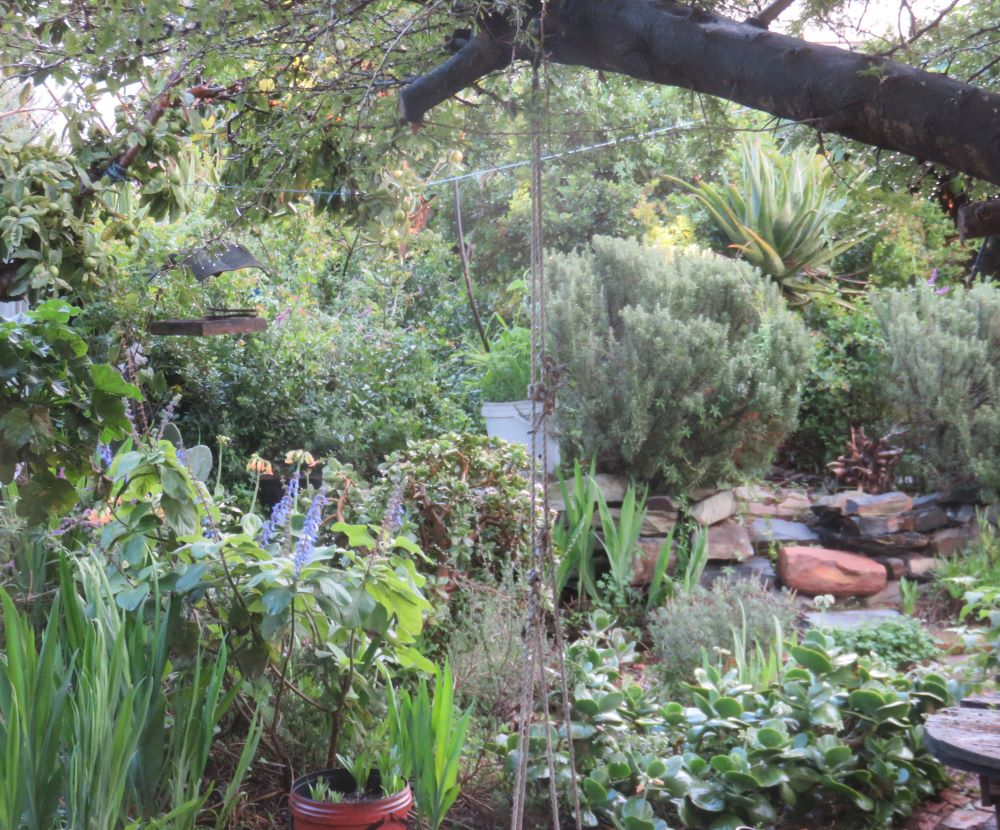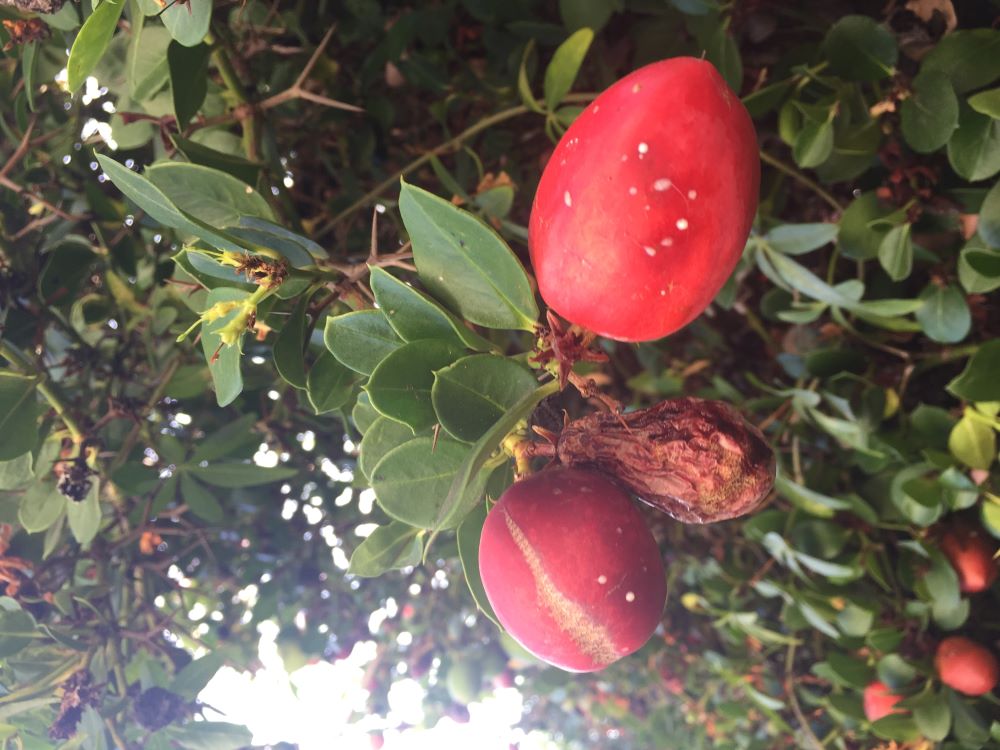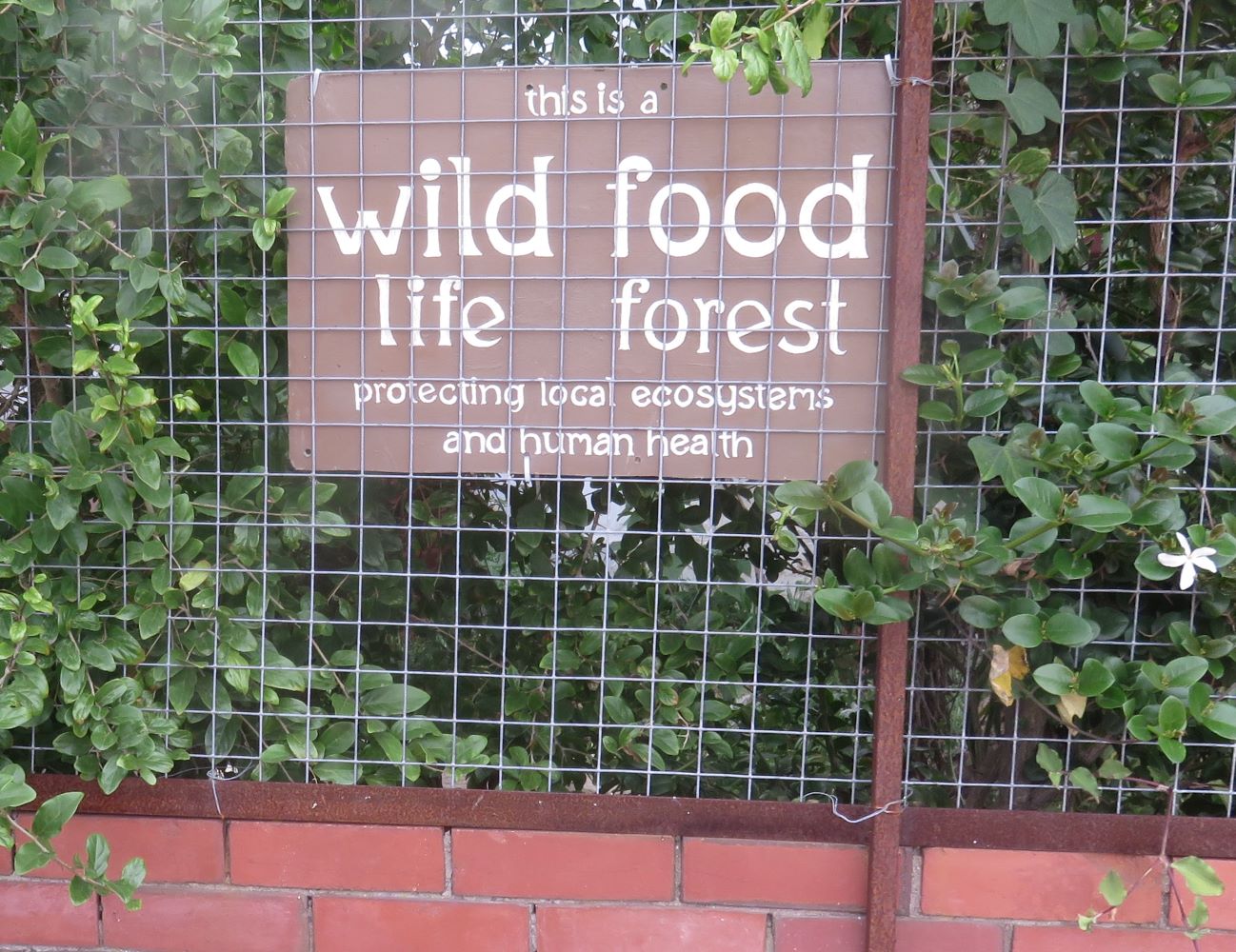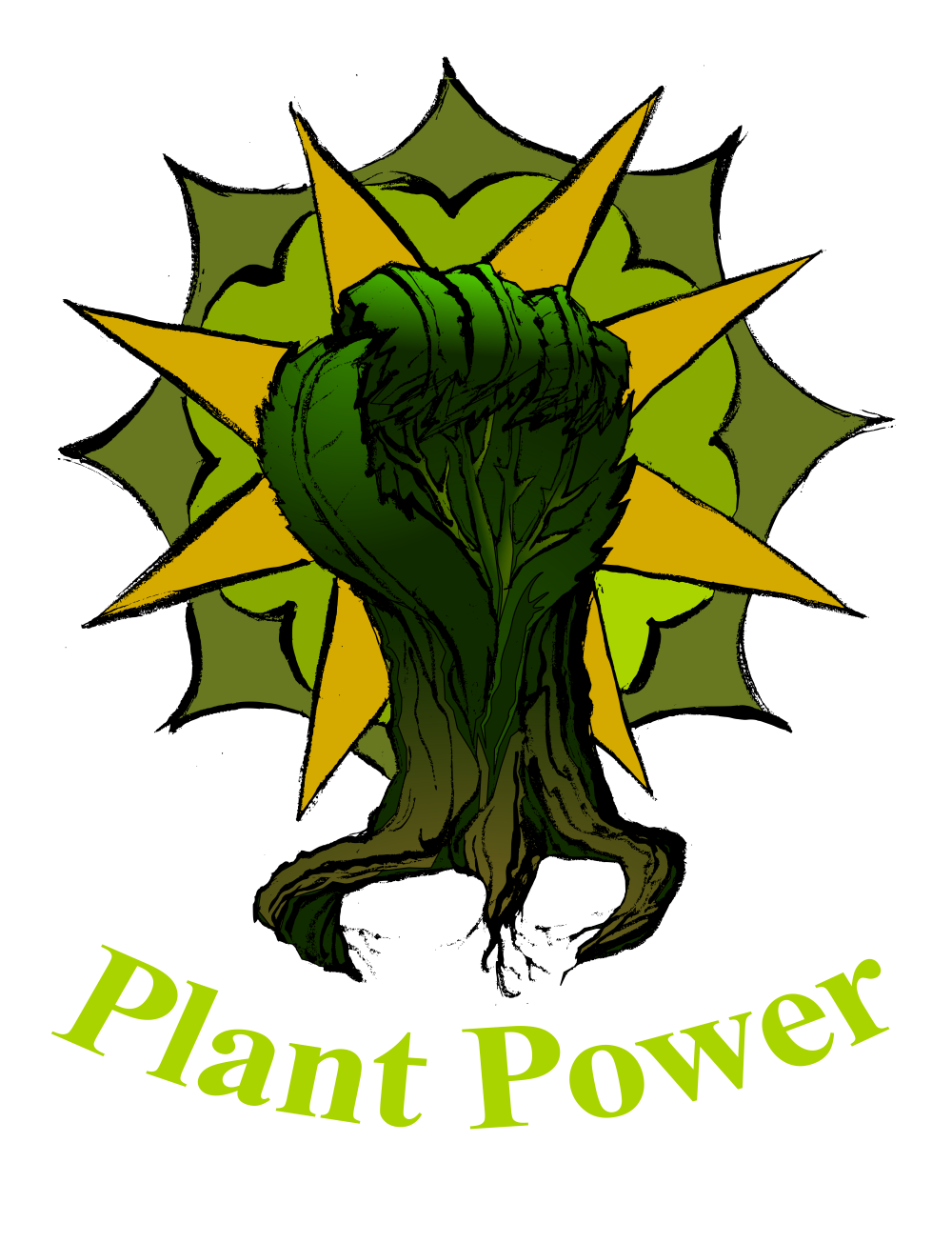Dear Reader, in this age of AI created content, please support with your goodwill someone who works harder to provide the human-made. Sign up at the top of the lefthand column or bottom of this page. You will receive my hand illustrated monthly newsletter RESTORE NATURE and access to the biodiversity garden design course as I write...and nothing else, I respect your time. I am also removing the advertizing as best I can as its become intrusive inappropriate and pays me nothing.
 My garden in the rainy season of winter, showing how I aim to increase plant diversity. As we have seasonal drought, many plants have adaptive grey foliage.
My garden in the rainy season of winter, showing how I aim to increase plant diversity. As we have seasonal drought, many plants have adaptive grey foliage.The power of plants
Do you believe in the power of plants ? Well believing isn't really necessary. I'll give you a few arguments below so that you may be convinced by reason. Nonetheless plants are so powerful that its hard to do them justice. I only hope my words will be able to strengthen your resolve to use them and leverage their power to achieve miraculous results.
Plants created our oxygen rich atmosphere, and made life as we know it possible. Plants are the basis of natural food chains, the drivers of soil restoration, insect and pollinator diversity, human health and climate parameters such as temperature and rainfall. Whether they are giant forest trees or microbes only visible by technology, they are the foundation of all life on earth.
What generates the power of plants ?
In short, it is the sun's power which drives processes on earth. Plants, great and small, are the only living things which can capture the energy of sunlight. They do this through photosynthesis. Delving into the molecular process of photosynthesis shows it to be enormously complex, so that it is no wonder man hasn't built photosynthesizing machines yet.
Plants store the sun's energy in carbon based molecules, and exhale oxygen and water. The carbon based molecules can later be broken up again to release the energy. The energy plants capture from the sun and store in a form which life can use for other processes, provides energy for most of the cycles of life in the ocean and other habitats, with few exceptions.
By absorbing carbon dioxide to produce the carbon based molecules, and producing oxygen as a by product, plants have made earth's atmosphere into an oxygen rich one, allowing oxygen breathing creatures like aerobic bacteria to thrive.
An oxygen rich atmosphere allowed the formation of ozone, a molecule consisting of 3 oxygen atoms, rather than the usual two. With time a protective ozone layer in the upper atmosphere developed, which absorbed electromagnetic rays such as UVB coming from space and reduced the bombardment of the earth's surface with dangerous radiation. This allowed larger creatures to evolve. Thus plants have enabled the development of all earth's oxygen breathing creatures from aerobic microbes to grey whales.
 Poison is not the plant kingdom's only ingenious weapon !
Poison is not the plant kingdom's only ingenious weapon !Plants as organic chemical factories
The carbon based molecules plants produce are primarily sugars. Plants can turn these primary metabolites into other secondary chemicals which they use for many purposes including self protection and construction with cellulose. Plants need a lot of protection, because they cannot 'run away' from predators or pathogens. Some of the protective mechanisms are aromatic molecules and substances poisonous to insects. These protecting molecules we in turn use as nutrients, medicines, gut health modulators, perfumes for covering our own odors, and so on.
Plants nurture the soil they grow in
to nurture themselves
Plants bleed a cocktail of beneficial chemicals, mainly sugar, into the earth through their roots in what Dr Christine Jones calls the liquid carbon pathway because the carbon in the molecules flows downward like sap. These plant chemicals are mixed to sustain particular soil organisms. Once in the ground, they will attract, or inoculate the soil with these organisms which are beneficial to themselves. The organisms, such as bacteria and fungi supply plant ready nutrients and water. The soil bacteria are also like chemical factories, and incredibly diverse in their metabolic characteristics. The fungi are like pipes for carrying the microbes and the nutrients, and extend the reach and area of the plant's roots many times.
The symbiosis of soil life and plant is necessary to the health of the plants and can supply them with the nutrients they need even if these are in very short supply in the environment and the native soil.
 My design on Redbubble, of exaggerated soil microbes caught in a network of hyphae.
My design on Redbubble, of exaggerated soil microbes caught in a network of hyphae.The power of plants to build soil
There are many reasons why plants are so important for building soil....more important for fertility than all the smelly concoctions of new and ancient organic practice, more important than the pretty packets of stuff from the agricultural supplier, more than the plough, more powerful than man to be sure.
The plants feeding the soil microbiome sustain an ecosystem below the soil which builds a loose structure called the soil sponge. This sponge, due to its open structure, very large surface area, and chemical nature has very good water and mineral retention capacity and allows conditions in which roots thrive, are protected against invasive disease, and optimize nutrient and water uptake. This leads to the plant being able to maximize photosynthesis and produce even more sugars, to feed even more soil organisms, building more soil. Thus plants alone can set a virtuous cycle of regeneration in motion.
The power of plants to cool the earth with hydrological cycles
Trees shade the earth and keep temperatures lower in their shade. All plants, even small ones, shade the earth, keeping it cool and allowing soil life to survive and thrive.
But there is more. I mentioned the excellent water retention capacity of the microbial based soil sponge, nurtured by the plants. Because a healthy regenerated soil sponge is holding as much water as possible under the particular weather conditions, plants can afford to open their stomata and exhale water vapor into the air.
As the water evaporates out of the plants it cools them by the latent heat of evaporation, or the cooling effect of evaporation. Splash your face with water and sit in a moving car and you will feel it !
This heat that was in the air is stored in a latent form in the water vapor given off by the plants. The planted area develops a blanket of moist air which rises slowly up as moist air does, carrying the latent heat up into the higher levels of the atmosphere. There the water vapor can condense as cloud and radiate off the latent heat, which then flows out into space. This convection effect cools the earth by carrying heat up to the thinner layers of the atmosphere where it can escape.
The condensing cloud becomes a white layer which cools the earth by reflecting sunlight out into space, called the albedo effect.
The currents of moist air rising up from the plants carry microbes exhaled by them, which serve as condensation cores up in the clouds, to form rain drops that cool the earth.
The falling rain scrubs particles of dust and pollution from the air. These particles would otherwise attract water vapor and form lower lying layers which trap heat, called hazes. At night, the heat stored in the mass of the earth's soil and rocks, buildings and so on, after a sunny day, can be radiated up and out into space if the air is clear.
The moist air above heavily vegetated areas like forests rises to bring in cool air from the ocean, which also bears rain. This type of stream from the ocean sustains parts of the Amazon rain forest deep in the continent. Deforestation and removal of vegetation close the coast can break the stream and dry out the interior.
The power of plants to heal and conserve soil
How many ways can the power of plants cool a local climate and bring rain to support more plants ? I have not counted yet. Perhaps you will. There are enough reasons for me to be totally sold on the idea that they can ameliorate climate change by cooling.
But that is not all they do. The soil sponge and the plant roots hold soil and prevent erosion of our precious arable soils. As said, the soil sponge holds a lot of water, and that dynamic buffers rain events, preventing flash floods and further erosion but it also keeps streams running for longer after the rains have gone and lengthens the growing season. The water holding capacity of healthy soil is augmented by its ability to hold minerals, called cation exchange capacity. The high mineral retention means that more plant nutrients are held in the soil instead of washing away. Thus plants grow and stabilize soil, and turn the environment into one more ideal for human and other life.
 An information board on my front fence surrounded by African fruit trees.
An information board on my front fence surrounded by African fruit trees.The power of plants to support biodiversity
MICROBIAL DIVERSITY
Each type of plant bears a different microbiome on the surface of its leaves and in its tissues and root zone. Therefore it stand to reason that plant diversity favors microbial diversity. Just like insect and avian diversity is crashing, microbial diversity has been crashing in many regions of the world where disinfectants, antibiotics, fertilizers and biocides are overused, and the human microbiome in these regions has been reduced in diversity with it. Microbial diversity in our gut, the good ones which we get from contact with soil and plants, is the foundation of human physical and mental health.
MACROSCOPIC DIVERSITY
If quite a number of the plants in our garden are natives, they will support greater insect diversity, as most of the insects and plants in a region have co-evolved to depend on each other, and many insects die out when the plant they depend on becomes extinct and vice versa.
Insect diversity will lead to a more stable and robust insect ecology, and insects support many other creatures like nesting birds, and insectivorous reptiles, amphibians and rodents. These in turn support animals higher up the food chain.
It is obvious that a diversity of native plants can boost diversity in a whole ecosystem, and they have the power to reverse some of the damage done to diversity and to our climate at next to no cost.
The power of plants as a climate and biodiversity 'solution'
The technology for creating an engine to lock down carbon, heal our hydrological cycles and increase biodiversity can be very simple if we leverage plants. In fact the technology for rehabilitation is so 'low' tech its been around for almost ten thousand years, and just about anyone can master it without studying engineering. This technology would include networking, teaching, backyard nurseries, seed exchange and growing wild food plants, and plants that are hosts to many insects, like our tick berry, which I've used in my mixed hedge along the back fence. What is truly amazing is that this technology is almost infinitely scalable without any damaging effects on the environment, like ore extraction or the burning of fossil fuels which all our other 'solutions' require. Given its cheapness and scalability and the beauty of the result of using the little chemical machines made by the creator, the mind boggles as to why other solutions to climate change amelioration are so dominant.
Be that as it is bound to be, because financial interests got us in this mess, and will not get us out again I fear. When rehabilitation of the earth gets complicated, forget everything else and just plant. It doesn't have to be a tree. All plants are important and they all have a place.
Below are links to the different threads on plants in this website.

Restore Nature Newsletter
I've been writing for four years now and I would love to hear from you
Please let me know if you have any questions, comments or stories to share on gardening, permaculture, regenerative agriculture, food forests, natural gardening, do nothing gardening, observations about pests and diseases, foraging, dealing with and using weeds constructively, composting and going offgrid.
Your second block of text...
SEARCH
Order the Kindle E-book for the SPECIAL PRICE of only
Prices valid till 30.09.2023
Recent Articles
-
garden for life is a blog about saving the earth one garden at a time
Apr 18, 25 01:18 PM
The garden for life blog has short articles on gardening for biodiversity with native plants and regenerating soil for climate amelioration and nutritious food -
Cape Flats Sand Fynbos, Cape Town's most endangered native vegetation!
Apr 18, 25 10:36 AM
Cape Flats Sand Fynbos, a vegetation type found in the super diverse Cape Fynbos region is threatened by Cape Town's urban development and invasive alien plants -
Geography Research Task
Jan 31, 25 11:37 PM
To whom it may concern My name is Tanyaradzwa Madziwa and I am a matric student at Springfield Convent School. As part of our geography syllabus for this
"How to start a profitable worm business on a shoestring budget
Order a printed copy from "Amazon" at the SPECIAL PRICE of only
or a digital version from the "Kindle" store at the SPECIAL PRICE of only
Prices valid till 30.09.2023







